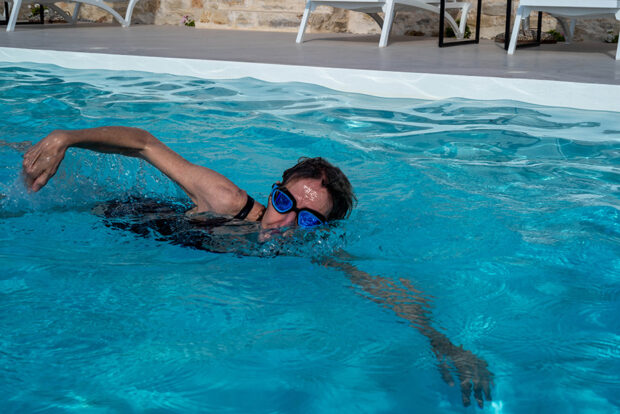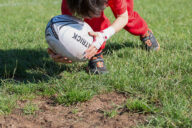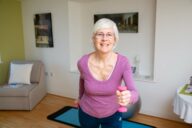There was always a fear of being in a pool or the sea when young. Paddling around at the edge of a beach or in the shallow end of a pool was okay – gripping a rubber ring to bob about in the water was okay, but the thought of having my face submerged in the water was absolutely terrifying.
I finally learnt to swim at age seven in a calm seaside bay, my father encouraging me to continue to walk out to chest level without floatation aids, keeping the big toe of one foot on the bottom until able to allow being held up with his hands supporting my body. With his encouragement, keeping my arms and legs moving, he began releasing his hands as the strokes were being made. My father then walked backwards towards the shore, all the while encouraging another stroke and another, until arriving at the water’s edge.
The vivid memory of this first swim – it felt very cold. My whole body contracted, jaws clenched tightly together, doggy paddling frantically, my neck and shoulders locked and stiff, chin stuck up above the waterline from a fear of getting my face drenched in water – a mixture of anxiety, freezing cold water, wanting to please my parents, coupled with a huge relief at not having drowned on completion. On reaching the shore some of the tension of my chattering teeth and tight shoulders began to lessen.
Weekly swimming lessons whilst at junior school were also in freezing cold water, shivering afterwards whilst getting dry, clothes sticking to a damp body and then given a mug of hot oxo to drink, as though that made it all alright. One episode during a lesson remained with me for years. After managing to jump from the top diving board, three boys thought it great fun to attempt to hold me under water in the deep end whilst I thrashed and kicked out, eventually getting my face above the water to gasp for air, when a teacher finally realised what was happening and ordered them off.
Over the years (even as an adult) if anyone came towards me to duck me under in a pool – the tension was extreme and voiced through a terror that communicated itself clearly to others to not do so.
Despite these early experiences I could eventually swim sidestroke (breaststroke was very painful on my neck and hips). I enjoyed floating on my back even in deep water. Being in cold water still brings that crushing feeling in my lungs and a sense of my upper chest contracting, jaw clenching and shivering throughout my body.
However, all of this makes sense when we consider that water magnifies our every movement. For example, when observing birds swimming on a pond, there are almost imperceptible ripples radiating 360 degrees outwards towards the sides of the pond as they move effortlessly through the water. If a bird suddenly moves to express some frustration with another, there is a marked change in the surface of the water around them, as choppy, distorted waves spread throughout the pond, causing a disharmony, from the centre point of that one event.
Changing My Relationship With Water
In more recent years, having observed a couple of people swimming a front crawl with a beauty and rhythm not seen before, I asked questions about where they had learnt this. This activated the request to attend a lesson with this teacher. Watching the teacher swim the crawl was an unforgettable experience, felt clearly within my body.
Her body glided along with very little disturbance to the water surface, her arms in an effortless rhythm, arcing up purposefully and super delicately out of the water in a deeply harmonious rhythm with her body and with a sense of deep spaciousness.
My relationship with water changed dramatically when attending a group swimming session with this swim teacher. The tension whilst standing at the side of the pool was initially enormous, with great trepidation at even getting into the pool down the graduated walk-in steps, feeling somewhat silly as an adult feeling fearful of water, when I could swim.
First surprise – the water was like stepping into the most exquisite warm bath and my body immediately surrendered the tension it was holding.
Second surprise – the water felt like silk gliding over and around the skin.
The teacher’s presence was absolute in strength, steadiness, her body communicating silently about being in water and enjoying it in a playful way – a completely different swimming experience. I experienced a deeply healing moment that brought tears to my eyes, as my body began releasing from previously held trauma with swimming and water.
For example – we were asked to walk in the pool with a focus on different emotions and to feel how it was experienced in the body as we walked one way and then back again without the emotion.
Just like the birds on a pond, the movement of the water magnified our every movement and we all felt how this affected everyone else in the pool – a beautiful and powerful reflection of how our movements throughout our daily life affect everything, be that in, or out, of the water.
Goggles in place, the next move was to glide underwater as far as possible and simply enjoy breathing out through the nose, experiencing the small bubbles around the face, before surfacing for more breath (in through the nose!).
From the continual reminder to be breathing in and out through the nose whilst swimming (or elsewhere in life) there was a realisation in my body, experienced as a deep self-nurturing with the unexpected feeling of gentleness in the lungs, that deepened to a delicateness with the conscious movement of breathing in and out through the nostrils.
My upper chest felt more expanded and open when breathing in through the nose: there was no harshness and enforced compression experienced in my lungs as I did, when breathing through my mouth – the nostrils doing their job, filtering the quality of air into the delicacy of the lung tissue, bringing a depth of clarity of working with my body, rather than against it. There was a noticeable sense of settlement throughout my entire nervous system – my body dropped the long-held-normal-tension of being ‘on constant alert’ for flight or fight.
The swim group was then introduced to overarm crawl, something I’d never attempted previously. This differed to most teachings – this was the reason why I was attending: to learn how to swim the front crawl breathing only through the nose on both the in breath and the out breath, no mouth breathing at all. Those already familiar with crawl and breathing through the mouth initially found this a little strange. For me it was a step into no-man’s land and having to simply trust the teacher and my body. Attending this lesson settled my nervous system and moved me through residual fears around being in water.
This brought a deep wonderment and inner joy and much to build upon with the quality of movement and rhythm of the breath throughout this different relationship with water.
Unfortunately, this warm pool was too far to travel to frequently and all local pools were very cold and that was a seemingly justifiable excuse to put swimming on hold!
The Joy Of Movement And The Crawl
Following a strong pull to visit a newly re-built leisure centre recently, it was a joy to have no loud, intrusive music playing and a slightly smaller training pool at warmer temperature. A restriction on numbers of people in the pool made it possible to continue building the strength of my legs and arms with the overarm crawl.
And so off to the pool I went, new swim goggles in hand to repeat gliding underneath the water several times – this felt gorgeous and playful and a very natural way to begin practising the crawl with only nose breathing. There were no expectations or effort on ‘getting it right’, only a clear focus on the movements in the moment with awareness of my body – open to the possibility of the three strokes being four, six, eight, ten strokes or more as my breathing style became more familiar with the movement and my legs strengthening with the repetition. I simply focussed on enjoying the movement within the water as a marker for daily living.
It was very freeing to not be in any competition with either myself or others, nowhere to get to and nothing to improve. I simply enjoyed gliding under the water in between repetition of the overarm strokes and breathing through my nose.
On the first day I did six strokes of crawl swim without trying or force.
On the second day the pool was very quiet. I wore short training fins that really supported the weakness in my legs and noticeably brought more power in the ease of movement of my body through the water.
I did two lengths of crawl, noticeably easier (and possible) with wearing training fins.
As I began the third length, suddenly there was an unexpected and deeply humbling shift in my movements – a movement I have never experienced before when swimming – as seen and felt when observing the swim teacher.
My whole body felt light, silky and elongated throughout my legs and spine. The movement of my arm lifted my body up slightly sideways out of the water with an exquisite sense of delicacy, grace and beauty, flowing upwards and arcing through the air space with no hurry and back through the water. There was a consistent flow to my movements, aligned with the harmonious rhythm of the in and out breath through my nose with no harshness or effort.
Thanks to the extra power in my legs from the training fins, my body was now moving in a similar way to the movement of the swim teacher, previously observed gliding through water, with barely a ripple. This was the experience for the whole length of the pool and a new marker for my body in this quality of movement.
In this, the old terror, tension, and anxiousness has been replaced by joy and play-fulness in water.
It is extraordinary to realise how an old and deeply embedded trauma and anxiousness that had held my body In a tight, hard and contracted state for decades, has been changed to the simplicity of a deeper settlement, more presence with my breath, and an awareness of being ‘in my body, spine and feet’ in every moment. All without perfectionism or trying hard to do so!. Seeing and feeling the joy and spaciousness in another’s movements (the swim teacher), has taken the emphasis away from the constant chatter of the restrictive, reactionary mental energy and has brought a deep and lasting change into my movements and life in general.
Others have also commented on how my body is now noticeably more fluid, harmonious and graceful in its movements. A great reminder is seeing ducks and swans on a pond or lake and the effect of their movements on the water! The joy to share is that this is possible for everyone.
Note: The term crawl in this blog refers to the swimming stroke also known as freestyle.
Further reading:
The Joy of Simply Swimming
Exercise – it doesn’t need to be hard work





